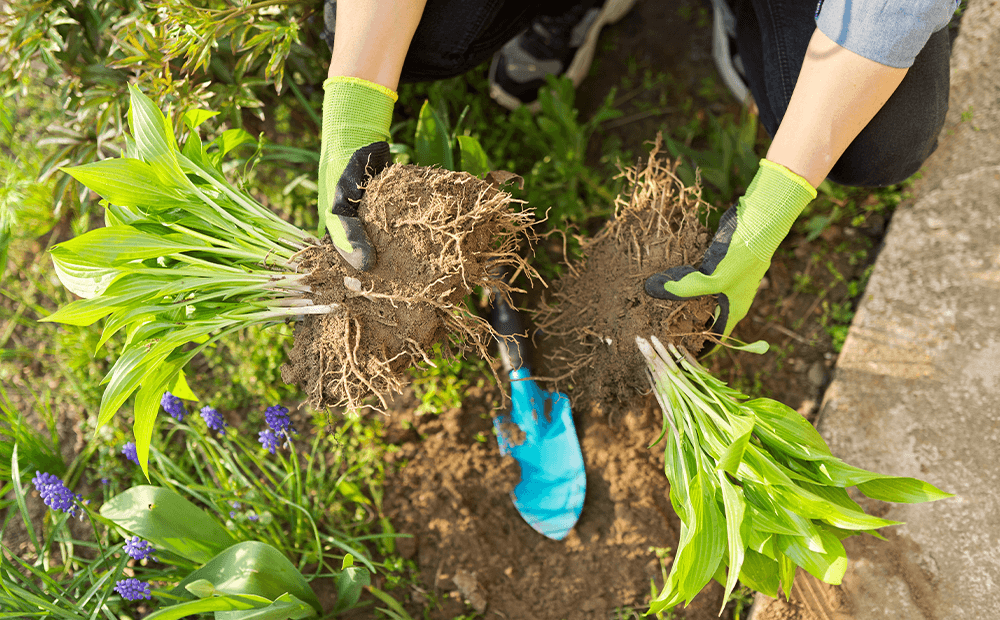THE DOWN LO ON DIVIDING YOUR PERENNIALS
Adding and dividing perennials in your landscape is a fantastic way to develop a beautiful yard that is relatively low maintenance. Perennials come back every year to fill your yard with blooms (with minimal effort on your part). But, they’re not completely maintenance-free. Most perennials need to be divided every few years. Dividing your perennials is awesome—who doesn’t love free plants to fill up your yard or to give to friends?
How Do You Know if Your Perennials Need Dividing?
If you’ve had perennial flowers for a while, you may start to notice that after 2-4 years, they begin to look a little lackluster. They may have weak or pale foliage, fewer and smaller flowers, and the plant itself might even start to look like a donut, with a dead spot in the center.
Those are the most obvious signs that your perennials need to be divided, but you don’t necessarily have to wait for those signs to show. It’s a good idea to divide your perennials before they get to this point, but sometimes life gets busy, so don’t worry if they’re already looking a bit sad.
Why Should I Be Dividing My Perennials?
Most perennials grow pretty densely and put out new shoots, tubers, or roots quite close to the main plant. This means they get pretty crowded where they’re planted. When they’re packed so tightly together like that, the plant may struggle to take up enough water and nutrients, and there may not be enough light getting into the center of the plant. These are all problems that can cause the plant to die back in the center.
Dividing your perennials helps give new plants more space to grow and spread their roots more comfortably, so they can get back to vigorous growing and flowering. It’s a win-win for everyone, the plants and you, or your friends.
There are many pests around when our plants are outdoors, but there is also usually a balance of predators like spiders, birds, and ladybugs that keep the population in check. Since most of those predators don’t live in our houses (we hope!), you have to be careful to check for and treat any pests when you bring tropical perennials inside.
Which Perennials Should I Be Dividing?
Not all perennials need dividing frequently. Peonies, for example, may not ever require dividing, although you can do it in the fall if you want more of them. Other perennials can be divided every 1-3 years, depending on the plant. If the plant has a peak year and is looking healthy and strong, it’s best you divide it that year.
You should aim to do your perennial dividing after the plants have finished blooming for the year. You can divide before they bloom, but they may struggle to establish since all their energy is being forced into flowers instead of developing roots. If you wait till they’re done blooming, they’ll start collecting energy to store in their roots for next season.
How to Divide Perennials
Most importantly, choose an overcast day to divide your perennials since the sun can cause a lot of stress, especially on the roots.
Use a sharp spade to dig up the parent plant, cutting down around the plant at the drip line, then angling under to loosen the root ball. Once you have the root ball dug up, you can split it up in several different ways. For plants like hostas or ornamental grasses, you can use a sharp spade or knife and simply cut the root ball into four quarters. A quarter of the original size is a good rule of thumb for how many times to divide your perennial plants.
When you divide perennials with lots of foliage, you can trim back the foliage by about 30% to give the plant a break from the stress of being dug up and split. If you’re not going to plant your perennial splits immediately, pot them into nursery pots, keep them well-watered, and store them somewhere shady until planting.
When to Divide Lilies and Daylilies
Lilies and daylilies can usually go 3-5 years between divisions. If you have reblooming varieties that bloom multiple times, it’s best to do it in early spring before they bloom. With lilies, you may want to use two garden forks back to back in the center of the root ball to leverage against each other and pull them apart.
When to Divide Hostas
You can divide your hostas in spring, summer, or fall, every other year. It’s good to give them a season to establish roots before dividing them. If you do it in the fall, make sure to do it at least six weeks before frost.
When to Divide Irises
Irises should be divided when they finish flowering, at least six weeks before frost. Irises grow from tubers and may be in a sizable dense clump. If possible, loosen and lift the entire mass together. Then brush or wash off as much dirt as possible, and then cut the tubers into chunks 4-6 inches long, with one fan of leaves per piece.
If you have any questions about dividing perennials, come chat with our expert staff at Dammann’s Garden Company, we can offer tips, advice, and tools to make sure your gardening is a success!




